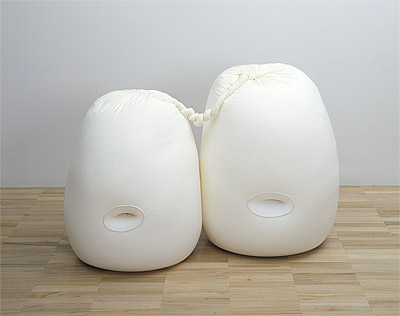Ernesto
NETO
Brazil
1964
Sonambulinos
1999
lycra tulle, polystyrene
overall (approx.)
110.0 (h)
x 130.0 (w)
x 70.0 (d)
cm
Gift of Geoff and Vicki Ainsworth 2001 Art Gallery of New South Wales, Sydney
Ernesto Neto’s manipulation of utilitarian materials including lycra, pantyhose, spices, sand, rice, styrofoam and lead balls, transforms the commonplace. His astonishing sculptures and installations―ranging from gargantuan pendulous forms and membranous caves that engulf entire gallery spaces, to sprawling fungus-like forms and colonies of biomorphic pods―are characterised by the use of soft, sensuous and erotic forms. He explores aesthetics and science, the body and its substances, the laws of weights and measures, and the concept of art as a living organism.
Neto is one a group of Brazilian contemporary artists indirectly expanding on the legacy of Neo-concretism. Dissatisfied with nationalist art traditions and dogmatic prescriptions for Abstraction in Brazil during the 1950s, the short-lived Neo-concrete group (1959–61) combined an interest in abstract geometric forms with social and sensory engagement. By making everyday materials into existential objects of sensory experience and social significance, they revitalised the relationship between artist and object and implicated the viewer as an integral part of their work.[1] Neto revives such concepts by way of material and form, and by inviting audiences to interact with his work. The viewer, via his or her very presence, is often essential in determining the meaning of the work of art.
Sonambulinos―an affectionate diminutive of the Portuguese sonámbulos, meaning ‘little sleepwalkers’―was conceived in the late nineties as part of a series of ‘ovaloids’ made from white lycra stuffed with styrofoam pellets. Some objects even invited the viewer to hug them, rest their head or insert their arms into bodily cavities. Here two amoeba-like pods with oversized belly-button orifices are joined by a twisted umbilical cord, their slumped form determined less by their delicate membranes than the weight of their styrofoam filling. Although highly sanitised, these visceral qualities conjure up associations with the human body, eroticism and an eerie sense of what these sleepwalkers might get up to when we’ve all gone home.
Niki van den Heuvel
Exhibition Assistant, International Art
National Gallery of Australia, Canberra
[1] Benjamin Gennochio, ‘Concrete poetry,’ World Art: The Magazine of Contemporary Visual Arts, vol 12, February 1997, pp 58–9; and Alisa Tager, ‘Report from Brazil: paradoxes and transfigurations,’ Art in America, July 1994, p 44

